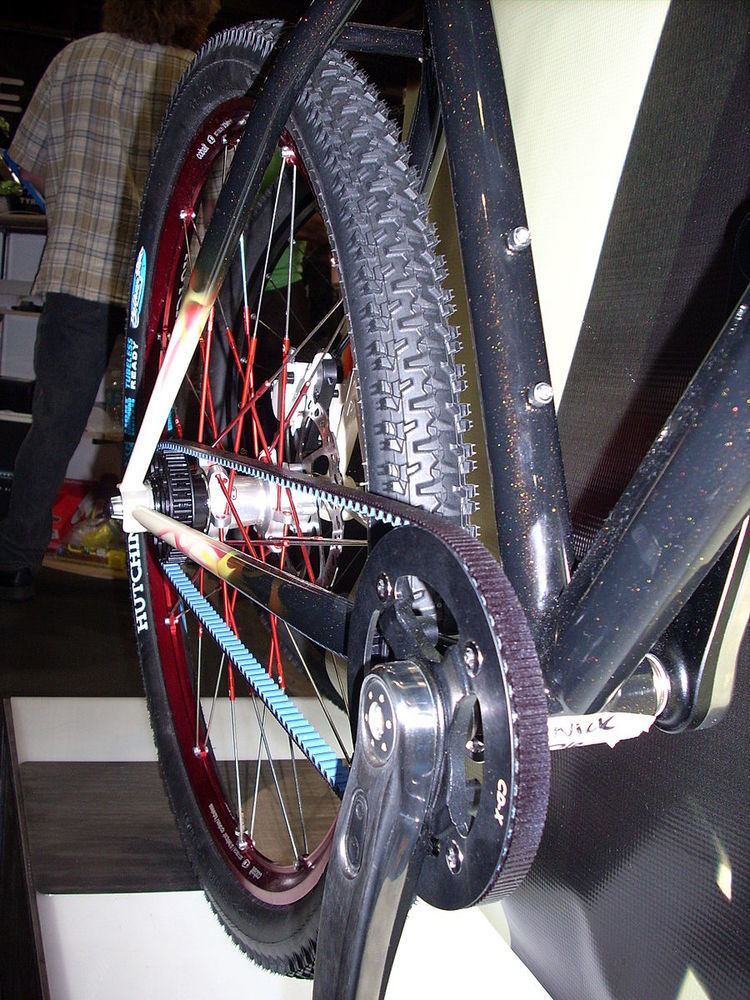 | ||
A belt-driven bicycle is a chainless bicycle that uses a toothed synchronous belt to transmit power from the pedals to the wheel. The belts are typically made by the same manufacturing companies that produce timing belts for automobiles, machinery, and other synchronous belt drive applications.
Contents
The application of belt drives to bicycles is growing, especially in the commuter bicycle market, due to the low maintenance and lubrication-free benefits. Belt drives are also available for stationary and fitness bicycles.
Benefits
Drawbacks
History
A belt drive for a bicycle was patented in the United States on April 8, 1890 by Charles D Rice, Patent # 425,390. No evidence has been found that it was ever used, but some motorcycles used leather belts in the early 1900s. The Bridgestone Picnica belt-drive bicycle was introduced in the early 1980s. It used a tooth-belt drive like auto timing belts and Harley-Davidson drive belts, along with a novel two-part chainring that increased belt tension with increasing load. The Picnica was a folding bicycle, and part of the appeal of the belt drive was cleanliness. The Picnica was a small wheel bicycle, so belt tension may have been less than on a bicycle with standard-size wheels. It was apparently successful, but was offered mainly in Japan.
Bridgestone offered belt drive bicycles in the USA until they left the market about 1994. Since their innovation, they have continuously offered belt drive bicycles in Japan including their best selling Albelt model.
In 1984 and 1985, Mark Sanders, a designer who had earned his degree in Mechanical Engineering from Imperial College, London, designed a folding bicycle as part of his graduate studies in an Industrial Design Engineering (IDE) program. The program was run jointly by Imperial College and the Royal College of Art in London. He collaborated with a design engineer from Gates Corporation to outfit his bicycle with a belt, rather than a chain.
When his project was complete, Sanders chose entrepreneur and former Greg Norman manager James Marshall and a Glasgow manufacturer to turn his award-winning design into a product. The manufacturer coined the name STRiDA, and in 1987 the bicycle began rolling off the production line. In 2002 production was moved to Taiwanese manufacturer Ming Cycle in order to meet increased demand, and as of 2007, Ming Cycle fully owned the STRiDA brand and intellectual property rights.
iXi bicycles, distributed in the United States by Delta Cycle Corporation, followed in 2004 with a compact design that, like STRiDA, featured a belt drive. Other folding bike manufacturers that have implemented a belt drive include U.S. company Bike Friday and Netherlands-based Bernds.
In 2007, Gates Corporation developed a high-modulus synchronous belt and sprocket system called the Carbon Drive System. The belt’s pitch allowed for lower tension requirements to help prevent skipping. Lightweight, patent-pending sprockets have Mud Ports, openings under each tooth, which work to slough off debris.
In 2009, an increasing number of bicycle companies, including Trek and f8 Cycles, offered belt-driven bicycles. While builders initially focused on single-speeds and internal hubs, in early 2009 f8 used a Gates-compatible fixed gear cog designed by Phil Wood & Co., offering a belt-driven fixed gear bicycle.
In 2009, Wayne Lumpkin, owner of Spot Brand and best known as the founder of Avid, designed a belt system called CenterTrack. In 2010, Gates Corporation acquired a patent from Lumpkin for CenterTrack, a new belt and pulley design that improves on the initial Carbon Drive System design. CenterTrack is more tolerant of misalignment than its predecessors. It is also lighter, 20% stronger due to a wider belt, yet has narrower pulleys, making packaging with the latest generation of internally geared hubs much easier.
In 2010, Daimler introduced the Smart eBike, a power-electric hybrid bicycle featuring Gates Carbon drive belt system. The eBike is emission free and is designed for a clean, grease-free ride. Other notable eBike brands include Grace and Pi-Mobility.
The possibilities for belt-driven bicycles are increasing as manufacturers of internal gear hubs (gears inside the rear hub, which allow riders of belt-driven bicycles to shift easily) are constantly innovating and introducing new designs such as the Shimano Alfine 11 and Fallbrook Technologies’s NuVinci. Other major internally geared hub makers include SRAM, Sturmey-Archer and Rohloff.
Another option to provide gears is using a bracket mounted gearbox like the Pinion P.18.
Manufacturers
Notable manufacturers of belt-driven bicycles or belt drives include:
